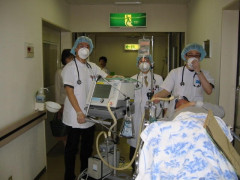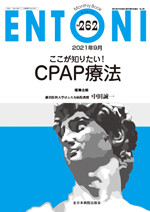情報提供 院長執筆
「特集:進化した呼吸管理Continuous positive airway pressure(CPAP)」
日本呼吸器学会誌(2014年第3巻第6号)に掲載された、呼吸器専門医向けの総説です。
この論文は、閉塞型睡眠時無呼吸(OSA)に対するCPAP療法の進化、装置の基本特性、自動CPAPの技術的な進歩、さらにはアドヒアランス評価の重要性に焦点を当てて、解説しました。
1. CPAPの進化と基本特性の理解
•初期のCPAPは「耐える治療」だったが、現在は呼吸イベントを感知し適応的に圧を変化させる高性能装置へと進化。
•高流量送風装置としてのCPAPは、吸気・呼気の変動に応じて1呼吸単位で制御される。
2. フローリミテーションに対する自動CPAPの役割
•OSAにおけるフローリミテーション(急性吸気制限)は、無呼吸に先行する重要な兆候。
•最新の自動CPAP装置は、これを早期に検出し、圧を適切に上昇させて上気道の開存を維持する。
3. OSAの新しい外来管理のあり方
•従来のPSG中心の管理から、在宅検査(OCST)を活用した管理モデルへの移行。
•在宅検査や治療へのアドヒアランス評価が保険診療の要件となり、臨床と技術の標準化が進められている。
4. CPAP療法におけるアドヒアランス評価の義務化
•米国の制度変化を例に、アドヒアランス(週5日、1日4時間以上の使用)が導入継続の条件に。
•アドヒアランスを可視化するCPAPソフトウエアやネットワークによるデータ共有が進化している。
耳鼻咽喉科領域の専門誌『ENTONI(エントーニ)』第262号
全日本病院出版会(2021年9月22日) ⇒購入はこちら
「CPAPのメカニズムと問題点 ―新型コロナウイルス感染症(COVID-19)と気道消化管(aerodigestive duct)の観点から―」 徳永 豊
Abstract(抄録)
人間の呼吸管と消化管は高度に進化し、並列リンクした気道消化管(aerodigestive duct)を形成している。閉塞性睡眠時無呼吸症(OSA)の持続陽圧呼吸(CPAP)は、1981年コリン・サリバンのnasal CPAP装置からはじまった。残念なことに、未だにCPAPは上気道を圧で強制的に開大する装置と誤解されがちである。また、無呼吸低呼吸が改善しない場合にCPAP圧を上げるというロジックがとられがちである。COVID-19のパンデミックの時代、CPAP圧は飛散防止対策が要求されている。どうするべきか? 最新のCPAPは、安静呼吸を維持するために吸気と呼気で高流量空気を可変させている。上気道狭窄の指標である吸気フローリミテーションをモニターしながら、代償性呼吸に瞬時に反応して、気道閉塞を起こさないように動作している。CPAP療法のポイントは、横隔膜がつくる吸気陰圧を、いかにCPAP装置に伝達するかである。気道消化管の鼻腔、口腔の医学的評価がキーポイントである。OSAの診療にパラダイムシフトが到来している。
Title:Mechanism and Issues of CPAP Therapy — From the Perspective of the Aerodigestive Duct and COVID-19
Abstract:
The human respiratory and digestive tracts have evolved to form a highly integrated structure known as the aerodigestive duct. Continuous positive airway pressure (CPAP), widely used in the treatment of obstructive sleep apnea (OSA), originated with Colin Sullivan’s nasal CPAP device in 1981. Unfortunately, CPAP is still often misunderstood as a device that forcibly opens the upper airway with pressure. Likewise, the logic of simply increasing CPAP pressure when apneas or hypopneas persist is still common. In the era of the COVID-19 pandemic, however, CPAP pressure requires reconsideration from the standpoint of aerosol dispersion prevention.
So, what should be done?
Modern CPAP devices dynamically adjust airflow to maintain stable breathing. They monitor inspiratory flow limitation—a key indicator of upper airway narrowing—and respond immediately to compensatory respiratory efforts to prevent airway collapse.
The critical point in CPAP therapy is how effectively the negative inspiratory pressure generated by the diaphragm is transmitted to the CPAP device. Medical evaluation of the nasal and oral components of the aerodigestive duct plays a key role. We are now witnessing a paradigm shift in the diagnosis and management of OSA.
◇睡眠時無呼吸症候群
◇禁煙

